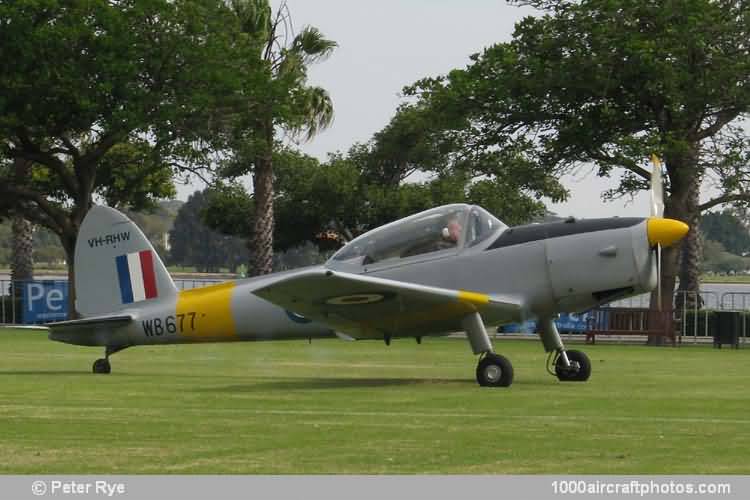07/31/2012. Remarks by Johan Visschedijk: "In the summer of 1945, during a discussion of postwar plans between the parent company de Havilland and de Havilland Aircraft of Canada (DHC), it was suggested that DHC should design an elementary trainer rather than the bush aircraft they were considering for immediate development. If a good aircraft resulted, the parent company would help market it. The idea was a good one for de Havilland had been well-known as a source of primary trainers for 20 years, the British company was busy with other projects, and DHC badly needed a design that could be developed quickly.
The design of the DHC-1 Chipmunk started immediately, and its concept was largely due to Wsiewolod J. Jakimiuk, Chief Designer of DHC. Lofting of the aircraft lines started on October 1, 1945, tooling began on November 16 and the first part manufacturing started on December 21. The prototype, CF-DIO-X, was completed, largely without tooling, and was first flown on May 22, 1946, at Downsview by Patrick W.P. Fillingham, well under a year after design work had started.
The Chipmunk layout was strongly reminiscent of the clean, Central European monoplanes of the late 1930s. The fuselage was of all-metal, stressed-skin construction, as were the fin and tail plane. The single-spar wing had a stressed-skin leading edge forming a D-spar while the rear portion of the wing was fabric covered. The wing was stressed for 9 g, a factor that was to contribute to its later popularity as an aerobatic aircraft. The control surfaces and flaps were metal structures with fabric covering. No float fittings were provided. A built-up canopy was fitted until, at the suggestion of the RCAF, it was replaced by an interchangeable bubble type, introduced on c/n 101
CF-CXA, some being fitted retroactively.
Fillingham complained that the rudder control was heavy, and the prototype was briefly flown with a cut-down fin and rudder, but they were returned to their original form, a minor change made to the rudder control system, and the type entered production. Later, enlarged elevators and rudder were introduced to improve control in aerobatic maneuvers. The enlarged rudder, with greater chord, may be recognized by the trailing edge being brought forward at its base.
The Canadian Chipmunks were largely adopted as military primary trainers; only five were sold to civil operators or private owners in Canada. The great majority originally appearing on the Canadian civil register were those issued by the Department of National Defence to the flying clubs for refresher training of ex-RCAF pilots. The reason for this was largely economic as the Chipmunk was more expensive than its civil competitors, and their side-by-side seating and cabin arrangement were usually preferred by club members and private owners. The last Canadian-built Chipmunks were accepted by the RCAF in the autumn of 1956.
All Chipmunk variants were fitted with a version of the de Havilland Gipsy Major engine. Canadian-built variants:
DHC-1A-1 Chipmunk Mk.1, Gipsy Major IC, partly aerobatic, 49 built.
DHC-1A-2 Chipmunk Mk.1, Gipsy Major 10, partly aerobatic, 12 built.
DHC-1B-1 Chipmunk Mk.1, Gipsy Major IC, fully aerobatic, 1 built.
DHC-1B-2 Chipmunk Mk.1, Gipsy Major 10, fully aerobatic, 2 built.
DHC-1B-2-S1 Chipmunk Mk.1, Gipsy Major 10, fully aerobatic, 18 built.
DHC-1B-2-S2 Chipmunk Mk.1, Gipsy Major 10, fully aerobatic, 22 built.
DHC-1B-2-S3 Chipmunk Mk.2, Gipsy Major 10, fully aerobatic, 53 built.
DHC-1B-2-S5 Chipmunk Mk.2, Gipsy Major 10, fully aerobatic, 60 built.
More Chipmunks could have been built in Canada had it not been for currency restrictions. Many customers did not have US dollars to pay for them, a condition imposed by the Canadian Government. However, the parent company demonstrated and sold the Chipmunk to the RAF and then set up production in England and supplied both the RAF and the soft currency customers. The Chipmunk became the first Canadian design to be built under license abroad. Sixty of the British Mk.20 version were built in Portugal by the Oficinas Gerais de Material AeronŠutico (OGMA) which was operated by the Portuguese Government.
The British built Chipmunks differed from the Canadian ones by having wings stressed for 10 g which necessitated reinforcing the wing spars at the root as well as the center section. In addition, the landing gear was moved forward, British instruments and equipment fitted, landing lights and anti-spin strakes installed; but the bubble-type canopy was not adopted. There were originally three versions, but some were later modified into other variants of the type.
British built DHC-1 variants:
DHC-1 Chipmunk T.Mk.10, Gipsy Major 8, 755 built for RAF.
DHC-1 Chipmunk Mk.20, Gipsy Major 10, export version of T.Mk.10, 217 built.
DHC-1 Chipmunk Mk.22, as Mk.20 but to civil requirements, 28 built.
DHC-1 Chipmunk Mk.22, T.Mk.10 modified to civil requirements.
DHC-1 Chipmunk Mk.22A, as Mk 22 but also fitted with larger fuel tank.
DHC-1 Chipmunk Mk 23, T.Mk.10 modified with Gipsy 10 for agricultural spraying.
Masefield Variant, a modification by Bristol Aircraft Ltd of a Mk.20, 21, 22 or 22A. Modifications included blown canopy, wheel pants, enlarged fuel tanks and wing luggage space.
The Chipmunk served well as a primary trainer in the RAF and the RCAF as well as with a number of other air forces. When surplus RAF and RCAF Chipmunks became available they found a ready market with private owners who wanted a nimble machine, and they became popular aerobatic aircraft and many were modified and re-engined to suit the ideas and purposes of their owners.
Produced for the RAF under s/n WB677, the pictured aircraft was delivered to the RAF on August 16, 1950. Six years later, September 24, 1956, the aircraft was sold at Maintenance Unit No. 10, Hullavington, Wiltshire, UK. Over a year later, November 11, 1957 it appeared on the Australian register as VH-RHW, registered to the Royal Aero Club of Western Australia. From 1962 the aircraft had a number of sequential owners, last and present owner bought it in 1973."

